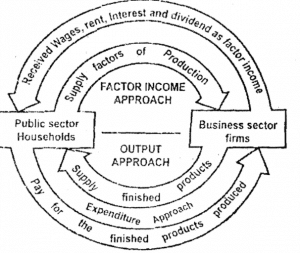Income is any money received. In any monetised economy, money passes from one person to another in exchange for currently produced goods and services.
CIRCULAR FLOW OF INCOME
The circular flow of income is a simplified way of showing the Net National product. To make this concept clear to the reader, the economy is assumed to be a closed one, that is, there is no foreign trade and has only two sectors viz: Business Unit consisting f firms and public sector consisting of households. The households are owners of factors of production, Households supply these factors of production, Households supply these factors to the firms for rewards in form of rent, wages, interest and dividends or profit is rewards become the Income of households. The firms convert the factors of production into finished products, which they in turn sell to households who are the consumers. The households use their income to pay for the finished products bought from the firms. The money received by firms become their income. This completes the cycle of income flow. Another cycle begins and the whole process is continuously repeated.
In the diagram:
- The value of finished products by firms represents the NNP through the output approach.
- Total amount paid by households for finished products represent the NNP through expenditure approach.
- Money earned by households as rewards for the supply of factors of production is known as factor income representing the NNP through the income approach.
Without savings by households and investments by firms, the circular flow of income remains consistently continuous. But in reality, savings and investments are made.
